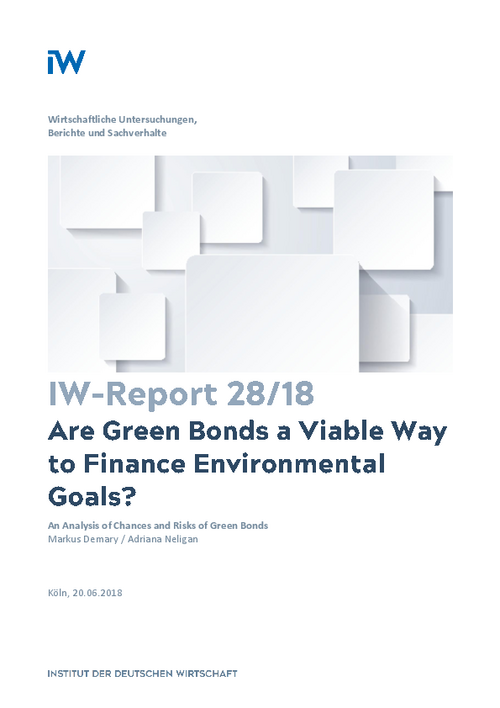The European Union is currently making significant strides to lead on green finance and align its financial system with its climate, sustainability and clean energy ambitions. The Paris Climate Agreement, the G20 Green Finance Study Group and the G19 Hamburg Climate and Energy Action Plan have provided ongoing momentum for policy moves towards a green financial system.

Green Bonds: Are Green Bonds a Viable Way to Finance Environmental Goals?
IW-Report

The European Union is currently making significant strides to lead on green finance and align its financial system with its climate, sustainability and clean energy ambitions. The Paris Climate Agreement, the G20 Green Finance Study Group and the G19 Hamburg Climate and Energy Action Plan have provided ongoing momentum for policy moves towards a green financial system.
Including financial markets into a climate strategy is a logical step forward, because public funds are insufficient to finance the needed investments in green technology and because the financial sector shows interest in financing green technology.
Given the long-term nature of green investments and the financial market’s short-termism, the establishment of a liquid market for green bonds is the market solution to this maturity mismatch. However, for such a market to thrive, investors need a definition of green technology as well as a definition of what a green bond is. In addition to that, green disclosure rules are needed, so that investors can easily access information on how the proceedings of green bonds are invested.
The EU’s main efforts in establishing a market for green bonds are the legislation of a common taxonomy for green bonds and the stimulation of the demand for green bonds by a green supporting factor in bank capital regulation. While we agree that a common taxonomy will help investors to screen green projects, we are very sceptical about the green supporting factor, which causes lower equity capital requirements for green investments. We see the risk that this may give rise to an undercapitalisation of banks with respect to the default risks of green projects and an overinvestment of banks into these projects. Since the green bond market is a political project, there is the danger of privileging green bonds in financial regulation for achieving political goals. The emergence of a green bond bubble and the bursting of that bubble would be harmful to the financial sector and it would hinder reaching the climate goals, since investors will abstain from investments in which they have lost money before.

Markus Demary / Adriana Neligan: Are Green Bonds a Viable Way to Finance Environmental Goals? – An Analysis of Chances and Risks of Green Bonds
IW-Report

More on the topic
Is the EU Fit for 55 and Beyond?
Ursula von der Leyen was elected President of the European Commission by the European Parliament in July 2019. She assumed office in November 2019 and unveiled the European Green Deal in December 2019 (European Commission, 2023a) as a focal point of European ...
IW
Compendium 5.4: CO2 Regulation of Road Transport in Europe
With the Compendium CO2 Regulation in Europe, the IW has been providing the interested public with a comprehensive collection of data on the development of CO2 emissions from passenger car traffic in the European Union, as well as on the applicable regulatory ...
IW